The 2022 Ford F-150 Lightning isn’t a whiz-bang gadget disguised as a truck. It doesn’t promise full autonomous driving. It’s not styled like something from a sci-fi movie. No, the Lightning is a regular, everyday F-150 with an electric powertrain shoved in, and that’s pretty much it. But this no-nonsense approach is actually the Lightning’s superpower, allowing it to reach the market quickly, remain within a price range that many can afford, and appeal to the masses by being familiar and unintimidating. It’s a key factor behind why I see the launch of the 2022 Ford F-150 Lightning as a major inflection point in automotive history. The other key factor is execution, and after driving the truck last week I can say with confidence: Ford nailed it.
After having driven machines like the Rivian R1T, Tesla Model 3, Kia EV6, Hyundai Ioniq 5, and Honda E, I’ve gotten used to the “weirdness” that tends to accompany EVs. Some might also call it novelty. It’s the wacky column shifter in the Hyundai, the absurd number of electronic gadgets and storage offerings in the Rivian, it’s the Tesla’s humongous screen in an otherwise oddly understated cabin, it’s the whole vibe of the Honda E. These are some great cars I’m mentioning, here, but to most laypeople, they’re kind of weird.
The Ford F-150 Lightning is not weird. Not even a little bit.

This was not the takeaway I was expecting. When I arrived at the F-150 Lightning press event in San Antonio, I figured the truck would be quirky like every other EV I’d driven recently, but at the same time I worried that it would be severely compromised given that it’s clearly built on the same architecture as the gasoline F-150. I was wrong on both counts.
(Full Disclosure: Ford flew me from Detroit to San Antonio, put me up in a nice hotel, and fed me such high quality food that I bet I could blend it up, strain it, and use the juices as starting fluid to fire up an old Ford 300 straight six).
The first point is simple enough: Ford didn’t really weird-ify the Lightning much over the standard F-150. Sure, there’s a big-ass screen in the cabin and there’s a frunk up front — plus the whole face looks a bit different — but by and large, the Lightning is familiar. As for the second point: For years the media and consumers alike have been criticizing EVs that are based on existing gasoline vehicle platforms. “Dedicated EV platforms or bust” has been the widespread sentiment for a while now, with many believing that the compromises associated with trying to adapt a gas platform to fit EV hardware just yield a watered-down product.
I agree with this, but only if we’re talking about adapting unibody vehicles — in other words, vehicles whose structural backbones are integrated into their bodies. As for adapting a body-on-frame machine like the gas F-150 into an EV? I think the compromises are significantly reduced in number and severity, and in fact, I think they’re downright worth making at this point in time. After all, as one Ford engineer put it during lunch: “The frame is the original skateboard.”
We’ll talk about that more later; for now, I’m going to spend quite a bit of time talking about the F-150 Lightning’s hardware.
A Look At The Ford F-150 Lightning’s Hardware
The Body
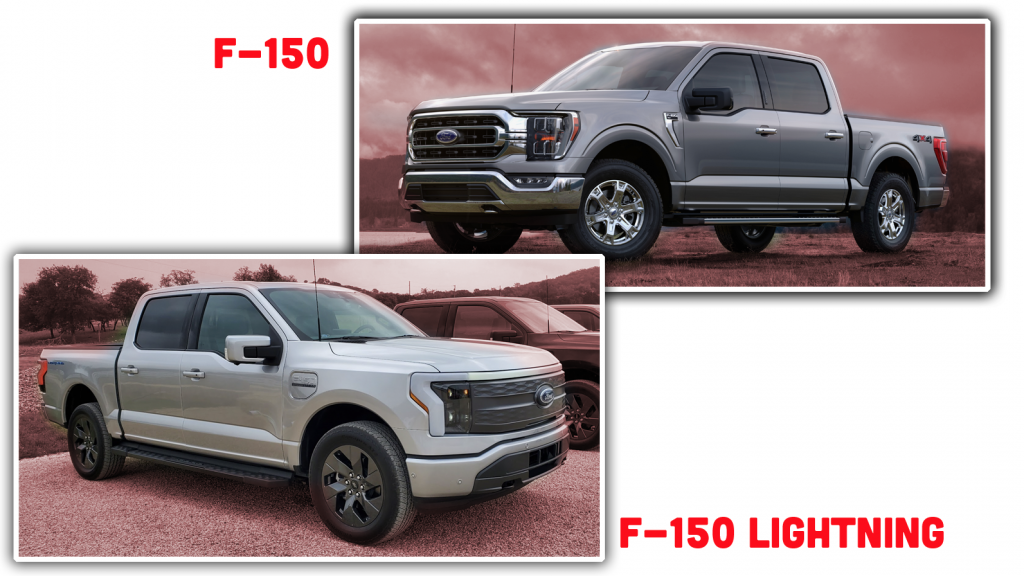
Let’s look at the F-150 Lightning’s aluminum body. Obviously, it looks remarkably similar to that of a standard gasoline F-150, and that’s because it is similar. One of the key enablers that allowed Ford to keep the Lightning’s cost down (the truck starts at around $40,000 with the standard battery and $50,000 with the extended range battery, which is dirt cheap for an EV its size), and to get the vehicle to market so quickly was component sharing. And of all shared parts between the regular F-150 and the Lightning, the biggest ones are cab, bed, and doors.
Still, despite the shared cab structure, inner box structure, and side closures, much of the Lightning’s outer sheetmetal does set itself apart from the standard truck’s. The front fenders, for example, are different; they have charging ports (okay, technically only the one on the driver’s side is real), and the gas truck’s strong arc-shaped crease above the wheel openings is gone, replaced with a large “wheel arch flat” that smoothly transitions into the fender.

The rear “box outer” panels share a similar difference: The gas truck has a sharp character line above the wheel opening, the Lightning does not; you’ll also notice that the provisions for the taillights aren’t the same, as the lights are different shapes. Plus the shape of the top of that outer box panel appears to be fairly plain on the gas truck, whereas the Lightning features a sharp horizontal line that almost gives off a “widebody” vibe. And, of course, the Lightning’s “box outer” no longer features a fuel door.
The Frunk
The Lightning’s hood and front fascia are not the same as those on the standard truck, and there are a number of other styling distinctions that Ford added to its first-ever full-size EV truck, but the main point is that the body’s main structural bits are shared between the gas F-150 and the all-electric Lightning, and that includes the hydroform rails under the hood. That’s these things:

Here’s a closer look at the passenger’s side hydroform rail:

So you get the idea: The Lightning uses a regular F-150 body, but reskins it, and as you can see in the image above, uses the void created by removing a giant internal combustion engine to create what the company calls the “Mega Power Frunk,” a storage area with an absurd 400 liter, 400 pound capacity. It’s awesome.
Ford did a nice job moving stuff out of the way to clear out all of that volume. I’ll get to the electric powertrain packaging setup in a moment, but for now, I’ll just show you some of the bits the company’s packaging engineers jammed around that frunk, behind those plastic panels that I removed, whose clips I accidentally dropped down into the dark abyss (Ford, using two-piece clips for the panels around the frunk was not the move).

For one, the 12-volt battery sits in the center, just behind the frunk, and can be accessed via the panel shown above. On the driver’s side under the plastic trim that I removed is a brake fluid reservoir, what looks like an ABS brake pump, a coolant bottle, and — hooked to that bottle — what appears to be an emergency release for the charging port,

On the passenger’s side is the windshield washer fluid bottle (whose lid pokes out through the plastic trim I removed), an AC refrigerant fill port, and what looks like a fuse box:

Just behind the frunk, right up against the firewall (you can see the indent meant for a transmission on the ICE truck) you’ll see a bunch of electrical connectors, coolant and refrigerant hoses/lines, and — on the left in the image below — a PTC heater. This is basically just a resistive heater (which works similarly to the coils on your stove) that warms up liquid coolant, which flows into a traditional heater core under your dash to warm up the cabin:
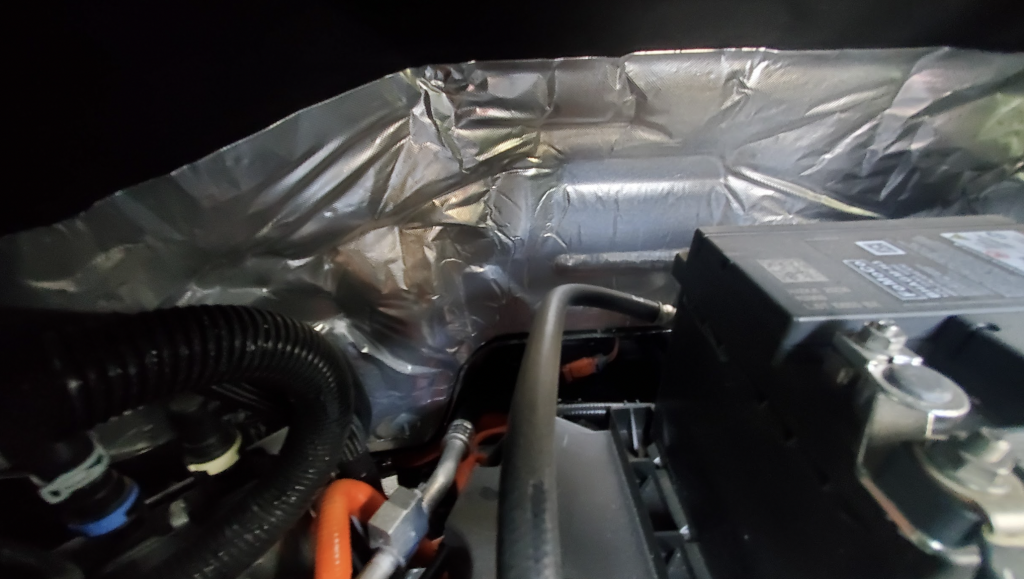
Here’s a closer look:

This is an old-school “legacy” heating setup that basically replaces an internal combustion engine (which is the typical source of cabin heat). The setup is a bit heavy and not particularly efficient compared to a heater core with resistance elements built in (eliminating the need for heavy coolant or any pumping action) and especially compared to a heat pump system, though the PTC will likely work well under extreme conditions and it’s fairly easy to adapt to the F-150’s current under-dash setup. So it’s not surprising to see it here.

The Cooling System
Also behind the frunk, as shown above, was a plate-style heat exchanger and a bunch of other hoses and pipes; I will admit that I didn’t have a chance to talk with Ford’s engineers about the Lightning’s cooling system, so I won’t discuss it much. I will say that I love what I saw in the vehicle’s lower front cooling opening:

Look at that nearly flat-mounted heat exchanger up front. It’s set up that way to allow for decent cooling capacity (the heat exchanger isn’t that small) while reducing aerodynamic drag, because instead of air flowing in and just bouncing around an aerodynamically-challenged engine bay, as is a common practice with most gas cars, the air is ejected out of the holes in the bottom of the truck. As a former cooling system engineer who hated “cooling drag” and how pressure buildup inside an engine bay tended to limit airflow to my heat exchangers, I’ve always considered the ducted cooling module my dream setup. Less drag, better airflow — what more could you want?

Anyway, enough about the body and frunk and cooling system, let’s check out the chassis.
The Frame And Suspension

The image above shows the Ford F-150 Lightning’s frame all loaded-up with its humongous 131 kWh battery, as well as powertrain and drivetrain components. Given that this frame carries the same cab and box as the gas F-150, it should be obvious that the two share body mount locations as well as a number of other dimensions , especially up front.

Ford really didn’t have much reason to change the front of the F-150’s frame, and quite a few reasons not to — the big ones being that the standard F-150 already had a suspension and steering setup that Ford believes satisfies its customers’ needs, and that the crash structure up front has already been optimized for tests like the grueling Small Overlap Rigid Barrier (SORB) assessment run by the Insurance Institute for Highway Safety. You can see that the provisions the standard F-150 has in place to pass SORB exist on the Lightning as well (pointed out with arrows two pictures down).

A Ford spokesperson told me a bit more about the commonality in the front structures between gas F-150 and Lightning, saying over email about crash optimization:
The frame in front is actually similar to the gas F-150. We have high strength steel on the side rails to compensate for the battery package. Most of the optimization was on the side, rear and mid sections. The frunk was also designed specifically with crash deliverables in mind. The team modified the front to accommodate the frunk and motors while keeping key features like SORB (small offset rigid barriers) near the front wheel location intact.

If you’re curious, here’s a look at the F-150 Lightning’s front suspension:


And here are some photos I creepily snapped of some random person’s gas F-150:


The rear part of the F-150 Lightning is where things get really interesting, because it’s a humongous departure from the gas F-150. Here’s what you’d normally find between the rear wheels of an F-150 — a solid axle:
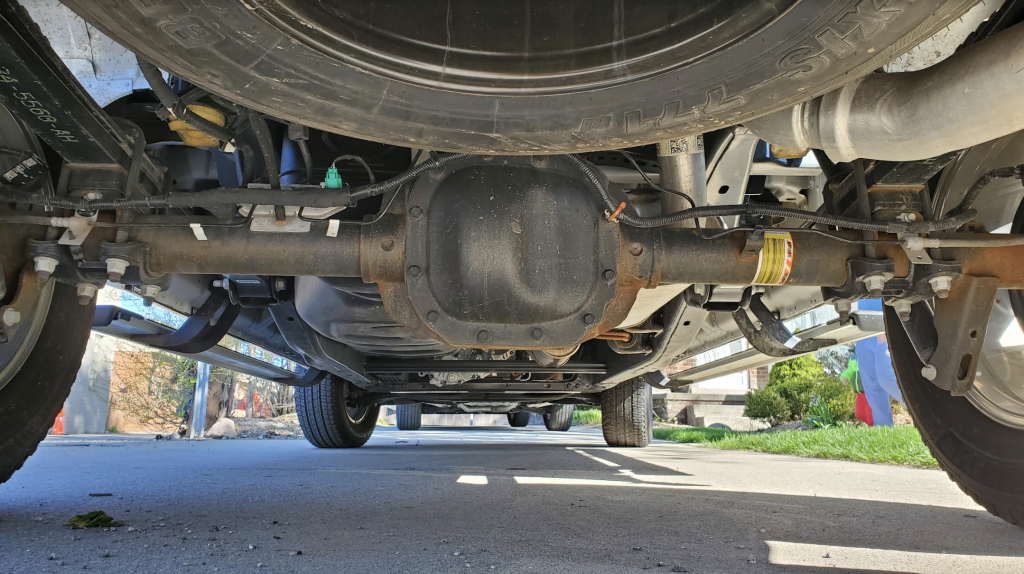
Solid axles aren’t really feasible for electric vehicles for reasons that our resident suspension engineer Huibert Mees explained in an article a few weeks back. The main factors are: Solid axles require driveshafts, which take up valuable battery space; solid axles with integrated motors are too heavy, and unsprung mass is bad for vehicle dynamics; and there are relatively significant losses associated with the power transfer in the differential of a solid axle.
So it only made sense that Ford developed a brand new independent suspension setup, and my god is it glorious. Here’s the look under the F-150 Lightning from the rear:



The axle is gone, as are the old-school leaf springs; in their places are a semi-trailing arm independent rear suspension and coilovers. Both changes are considered fairly massive improvements in terms of ride and handling — the reduced unsprung weight makes it easier to fine-tune the truck to optimize both.


The first thing you notice when looking at the rear suspension is the sheer size of the control arms; they’re unbelievable:

Look at how huge the casting is! Check out how tiny my hand looks in relation!:
This new suspension was probably a major investment on Ford’s part, but unquestionably the right call over trying to make a solid axle work.
The Battery

Let’s look at the center section of the frame — particularly the bit that holds the battery — and compare it to this center bit of the gas F-150’s frame:

One thing Ford made clear is that its team reinforced the hell out of the rails in this wheelbase-area as a way to protect the battery from side impact crashes. I believe it; the fully-boxed frame is seriously beefy.

The liquid-cooled battery pack is made up of enough pouch cells to yield 92 kWh of usable capacity in the standard-range models or 131 kWh of usable capacity in extended-range models.
The way the pack is mounted between those frame rails is quite interesting. The big battery is actually bolted to a large steel, structural ladder-shaped subframe (you’ll notice fewer crossmembers than on the gas truck, presumably because this subframe is stiffening things up), with rubber isolators between the pack and the ladder. The isolators should protect the battery from major shock loads that enter the frame; other benefits of those mounts may have to do with allowing frame flex, and there may also be NVH-related advantages involving harmonics, though I’ll update this article when I get word from Ford on its main considerations when choosing to isolate that battery. Anyway, here’s a closer look at the battery’s ladder subframe:

Here’s a closer look at how the ladder subframe mounts to the truck:

And here’s an up-close of some rubber isolators between the subframe and battery pack:

Honestly, it seems like battery removal for servicing wouldn’t be too difficult. There are some high-voltage plugs in the front shown below in orange, and there are some coolant inlet ports (in red) — and I assume the same plugs are at the back of the battery, connecting it to the rear drive unit — but otherwise it appears to be eight bolts and the battery pack (along with its subframe) are coming straight down.

[Editor’s Note: I think this easy battery removal will prove to be a very big deal as these trucks age and end up on the used market. Not requiring major surgery to swap batteries is fantastic, and I’ll be curious to see if a remanufactured/third-party F-150 Lightning battery ecosystem develops. – JT]
The Powertrain

All Ford F-150 Lightnings are all-wheel drive, at least for now. They feature the same three-phase permanent magnet AC motor at the front and rear, packaged between the frame rails and bolted to a roughly 9.65-to-one gear reduction. I say “roughly,” because, per a Ford engineer, the two gearboxes actually have slightly different gear ratios as a way to quell concerns related to harmonics. “Why even put yourself in that situation?” the engineer asked me, saying there’s no downside in having one motor run at a slightly different RPM than the other; this can make a difference in ensuring that the two motors don’t constructively interfere and create a Noise, Vibration, Harshness issue. (Incidentally, that same engineer told me that, during highway cruising, Ford found that running a 50/50 torque split between front and rear motors was most advantageous).
Here’s a look at those motors’ guts:


Here’s the motor controller that’s integrated into each drive unit. Its job is to make sure the motor does what the driver tells it to do (accelerate, regen, go in reverse, etc):

The gearboxes, by the way, are axial/planetary types, meaning the motor is parallel to the output shafts (one axle goes through the center of the motor). That’s why you can see that both motors are right in line with the axles (Teslas tend to have the motors offset with the gearbox output, so the Motor is either in front of or behind the axle).
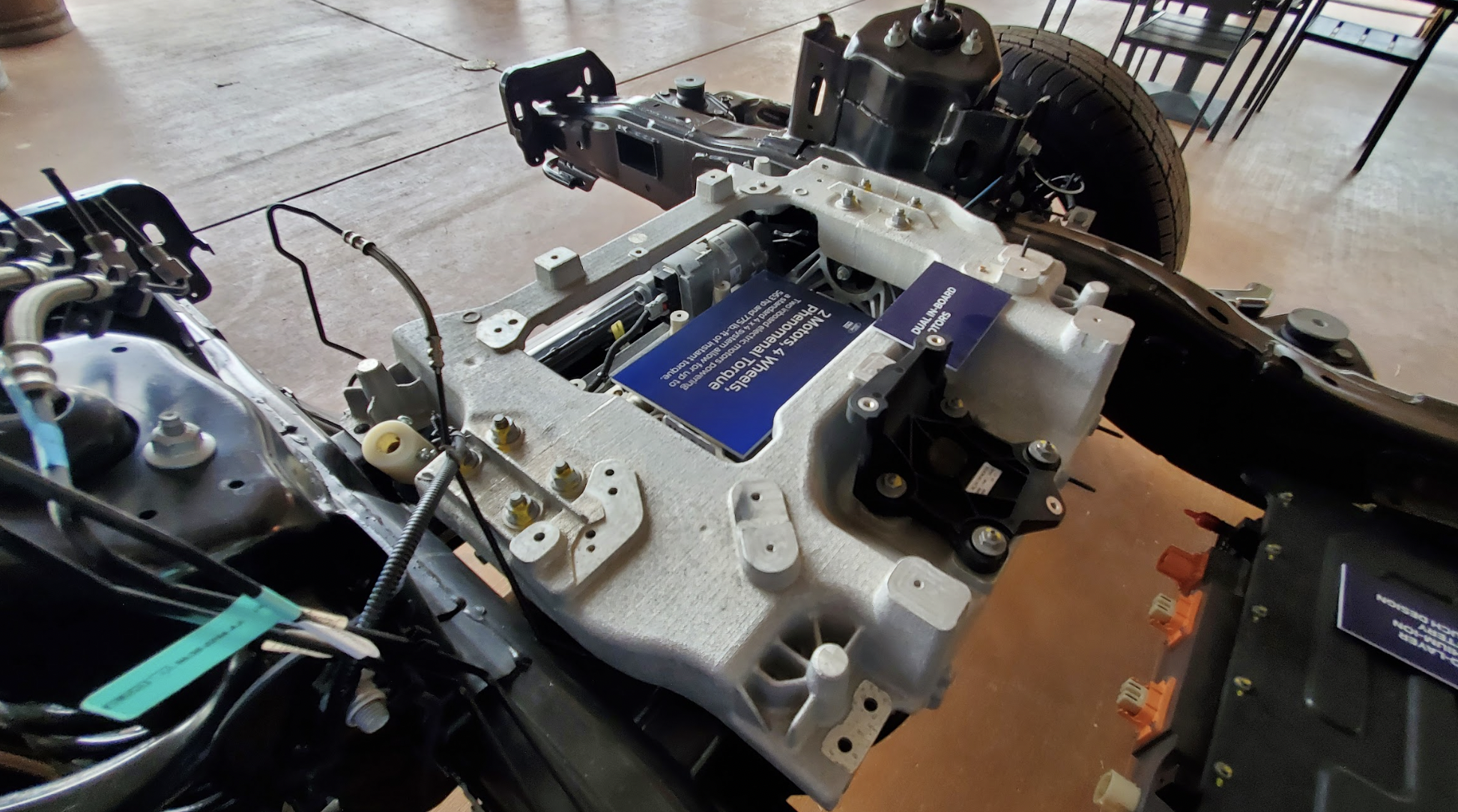
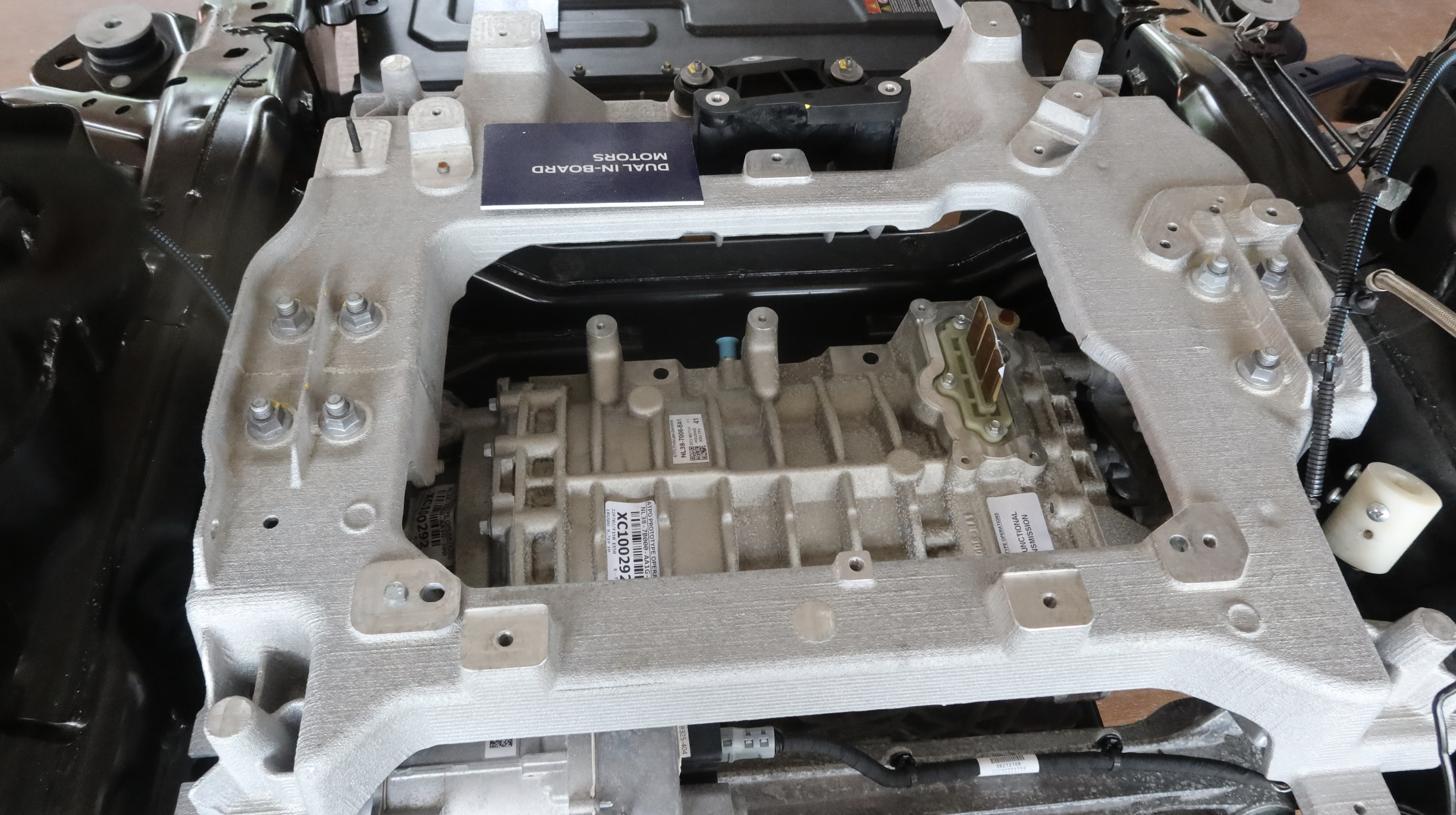
Let’s have a quick look at that front motor. It hangs from a cast aluminum bracket that’s bolted to the frame. It has a bunch of provisions for, presumably, an inverter and power electronics, and you can see that in the rear there’s a black bracket for one of two high-voltage AC compressors (Ford says it uses two to feed chillers for optimal thermal performance in high-load, high ambient temperature situations).
Here’s a closer look at how that front drive unit hangs off that cast aluminum subframe — you can see round rubber mounts:
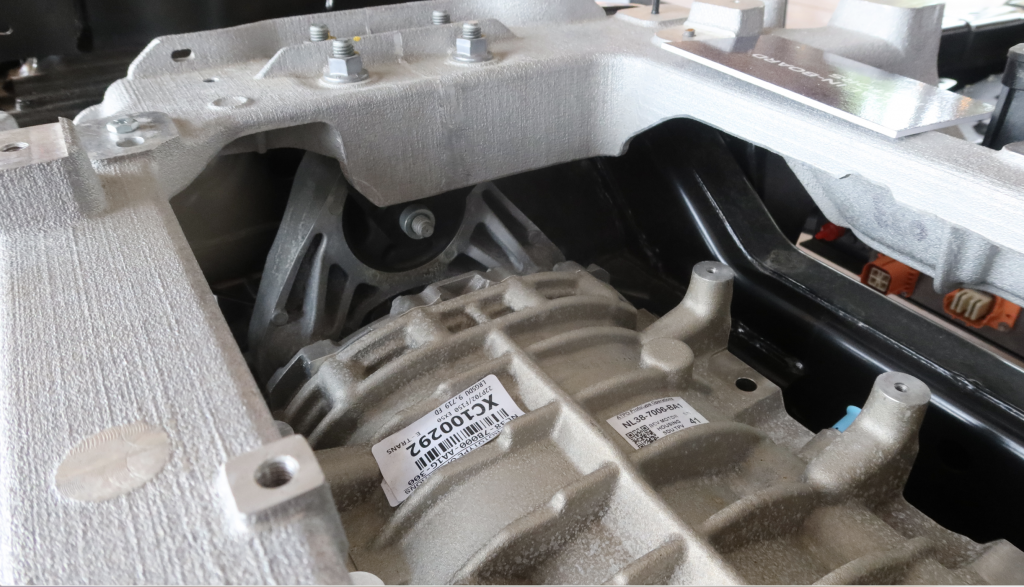

Of course, with just two mounts, as soon as you’d hit the accelerator pedal, that motor would just spin about its axis, so here are the two additional torque mounts. They’re two dogbone-shaped links that tie the drive unit to a front frame crossmember (which is different from the gas truck!), which is also where one of the front suspension control arm mounts ties into (also: notice the plate-style heat exchanger on the drive unit):

While we’re on the topic of crossmembers, it’s clear that Ford is making the most of them. The rear drive unit also shares a mounting location with the humongous control arms. Here’s a look at the rear drive unit, which you can see clearly along the same axis as the rear wheels:

Here’s a zoomed-out view of that shared crossmember, which I’m going to now dub the Mega Power Crossmember:

Here are the motor mounts. up close:
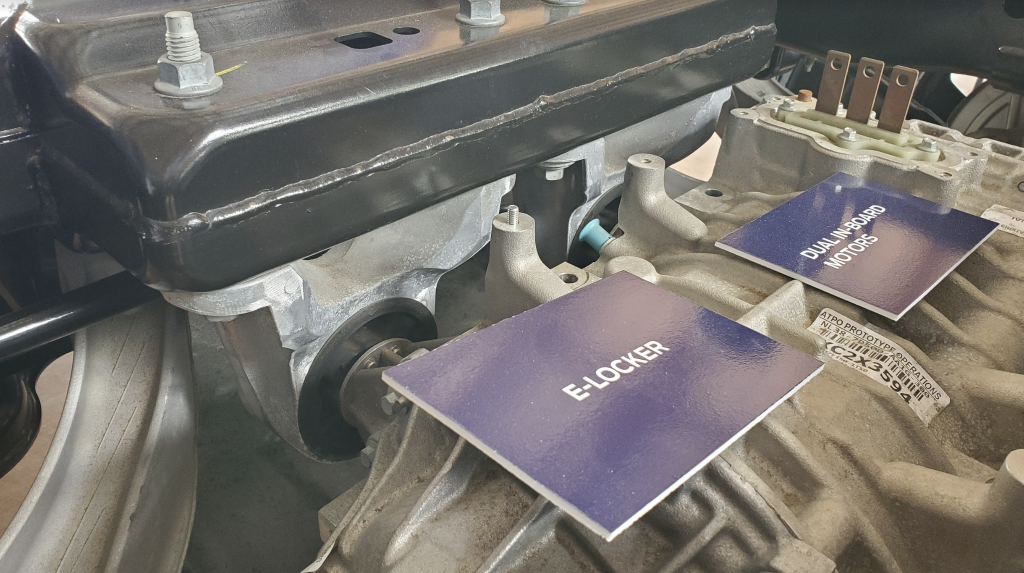
And here you can see where those massive control arms tie into that same crossmember (and like on the front drive unit, you can see a plate style heat exchange bolted onto the rear unit):


The rear motor has two additional mounts — at the two brackets that point straight down from the frame on either side of the spare tire:
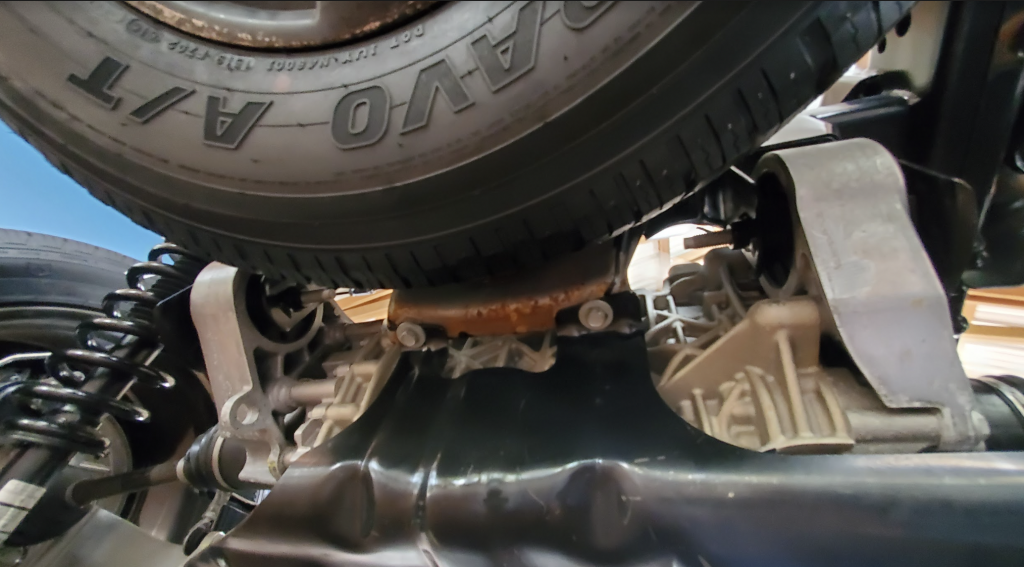


Anyway, I could spend another 5 million days writing about this truck’s hardware, so I’ll stop and ask you to watch the video below so I can get to the subjective stuff.
What’s It Like To Drive?
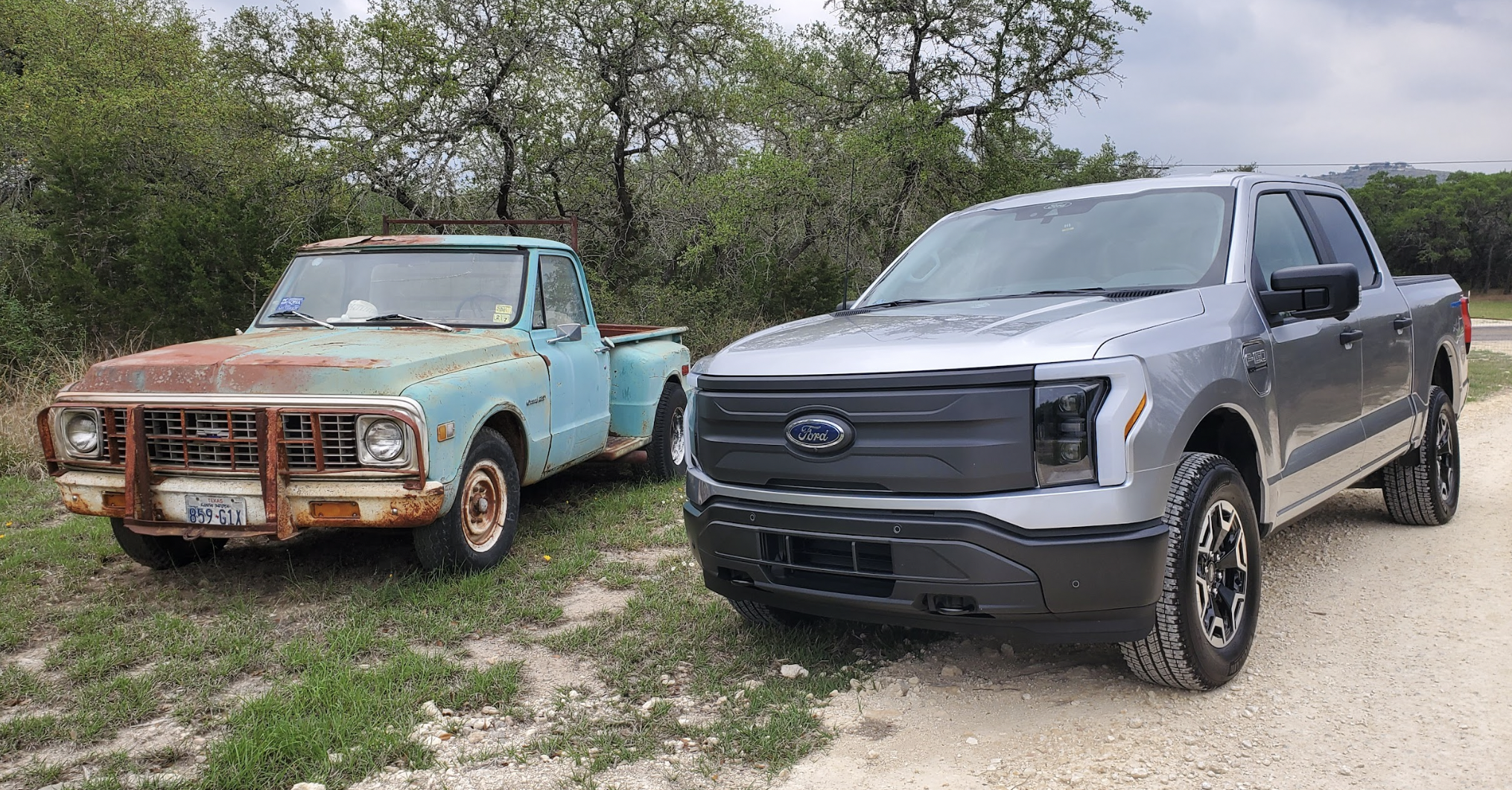
The first F-150 Lightning I drove was a $56,100 base “Pro” model with the extended range battery that promises 320 miles of range (the smaller pack offers 230, per the EPA). This is a fairly basic truck, with vinyl floors, synthetic leather seats, and an interior devoid of too many frills.
The Cabin Looks Familiar, Sounds Anything But

Everything about the cabin feels like a regular F-150, and that’s because the Lightning shares the gas truck’s interior; it even shares bits you wouldn’t expect it to share, like the chunky T-handle shifter, which is a far cry from the dainty “shifters” one tends to find in other electric vehicles.
Ford’s parts sharing, especially here in the interior, is a brilliant strategy, and not just for the obvious “It saves cost” reason, but because it offers truck buyers familiarity. The reality is that there’s still a bit of a hump that traditional pickup truck customers need to get over before they’re fully onboard the electruck train; to offer them a vehicle that looks and feels like an F-150, but introduces the many benefits of an electric powertrain is a great way to transition the masses to the new technology without shocking them with too much gadgetry.
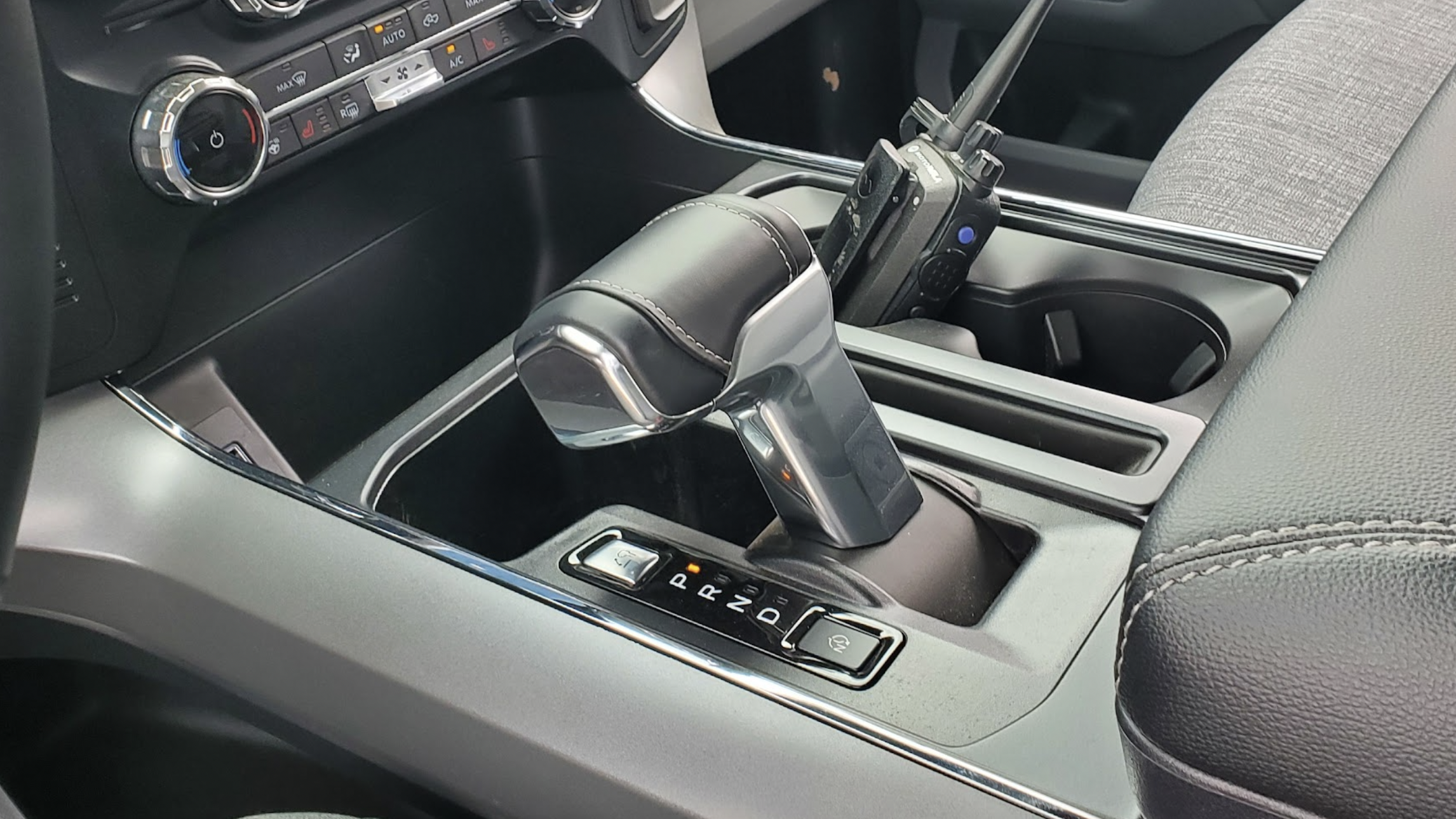
The F-150 offers truck buyers the chance to head to a dealership and drive a gas and electric version of essentially the same truck, so they can really see the differences that EV technology offers in terms of performance. And that, I think, is going to go a long way to convincing truck buyers that EVs are worth their money.

Hopping into the truck, I clicked the “start” button, and shoved that satisfying shifter into “D,” before pressing the accelerator pedal and quietly inching the big, heavy pickup through downtown San Antonio towards the freeway. When I got there, one thing became abundantly clear: The Ford F-150 Lightning may be the quietest vehicle I’ve ever driven. It is absurd how well-isolated that cabin is from tire noise, wind noise, neighboring car-serpentine-belt-squeal noise, you name it — the inside of the truck is a borderline sensory deprivation chamber, with aero noises only making themselves even worth noticing at speeds above 70 MPH, and road noise really the only noticeable audio signal to your brain during most driving.
My lack of sleep the night before, combined with the quiet cabin, led me to pull over and actually go to sleep in the middle of my test drive. Which I’ll remind you, is my job. The F-150 Lightning forced me to sleep on the job. My reputation is in jeopardy.

Lariat and Platinum models get a Lightning-Exclusive 15.5-inch infotainment screen and some other changes to the interior, so for those of you not interested in those vinyl seats and floors, here’s a nice dashboard to go along with your fancy Latte:

On the fancier trucks, you can also get “BlueCruise,” a feature that allows for hands-free driving, though you have to be ready to take over. I’m not a huge fan, since I think I may as well hold the wheel if I might have to jump in any moment anyway, but — despite a few hiccups — I will say that the system allowed me to drive on a nicely-marked freeway for roughly 15 minutes without me having to provide input. Perhaps over time I’d have appreciated that.
Acceleration, Ride and Handling
The Ford F-150 Lightning that I drove makes 580 horsepower and nearly 800 lb-ft of torque. The thing, as shown in the video above, is an absolute slingshot, with full-pedal applications forcing my head hard against the headrest as the vehicle rocketed to 60 mph in not much more than four seconds. Like most EVs, the Lightning responds to input with immediate and unrelenting fury beyond what most have probably ever experienced in any pickup truck. Dodge Ram SRT-10 be damned.
The Lightning’s ride quality is great. The suspension never feels jittery or harsh; it’s confident and stable. I can’t tell you how much better the ride is compared to the solid axle-and-leaf spring-equipped gas truck because I daily-drive old junkers, so my butt-sensors are all sorts of out of whack. (I find the gas F-150 to ride beautifully, too). Still, there was no head-toss where I might have expected it on the solid-axle truck, particularly when hitting bumps in turns.
Speaking of the turns, I did not approach any at speeds that I’d consider even remotely “high” (hell, or even “moderate”). Despite its near-50:50 weight distribution, this is a pickup truck, not a sports car, and I’m not trying to die. Is this truck heavy at over 6,500 pounds? Yes. Could I feel that in the turns? Sure. But lots of trucks are heavy, and I found the Lightning’s handling to be just fine, with the truck having some body roll, but less than I expected.
It Tows Like A Boss, But Prepare For Torque Steer

A number of you likely want to know what the F-150 is like when it comes to towing and especially towing range. And while I can’t answer those fully, I did have a chance to tow a 4,500 pound airstream for about a half an hour, and I took a peek at a bunch of different trucks to see how much range they expected when hooked up to certain trailers.
First, I’ll discuss towing performance. The truck above handled that Airstream like an absolute boss. I’ve done a lot of towing in my life, usually involving broken cars on U-Hauls, and no towing that I’ve ever done was remotely similar to what I experienced in the Lightning. Usually when you’ve got 4,500 pounds hooked to your hitch, you adjust your driving style. If you merge onto a highway, you might look especially far back in that side mirror to make sure nobody’s within’ at least two counties of what will be a glacially slow acceleration to highway speeds.
But in the Lightning, that’s just not an issue. The output of those motors is so prodigious that, even with a trailer hooked up, stomping on the accelerator pedal yielded instant, and downright impressive acceleration. I think the truck, even with a 4,500 pound trailer, could do zero to 60 mph in under seven seconds. That’s just a guess I pulled out of thin air, but the mere fact that I’m predicting anything below 10 seconds should tell you how absurdly responsive the truck is while towing.
[Editor’s Note: I’d like to point out that the dash display in this video is interestingly minimal; David told me it’s a special “calm” mode, perfect if you’re someone who hates overstimulation. Personally, I like my display to look like the bridge of a spaceship, but I get the appeal. – JT]
One thing I should mention is torque steer — the tendency of a vehicle to turn on its own under acceleration. On the Lightning, particularly when loaded up and when the driver is heavy on the pedal, torque steer is pronounced. While towing, if I stomped on the pedal, the wheel would want to jerk counter-clockwise. Keen to avoid the oncoming lane, I naturally made a steering correction, which led the traction control system to send power to the opposite wheel, leading me to again make a correction, which sent power to the other wheel on the front axle, and on and on.
Too much pedal would sometimes got me into a cycle where the truck would lose grip on one front wheel, torque-steer, I would correct, power would transfer to the other side, which would lose grip, I’d get more torque steer and make more corrections, and the whole thing was just bizarre — I’m hacking away at this wheel as the truck is chirping the left tire, then the right, then the left, then the right.
Obviously, heavy throttle while towing is a fairly narrow use case, but I noticed the issue even while accelerating out of turns — one tire would chirp, torque steer would join the party, I’d try to boot torque steer out of the front door, and then it’d just come right back in the back door, and it was all just a bit odd.
Also relevant when towing is the tow-vehicle’s weight. A fully-loaded F-150 Lightning comes in at around 7,000 pounds. And while this isn’t ideal for handling and efficiency, it could be advantageous in terms of towing stability. I haven’t spent enough time towing with the Lightning or the gas truck, but I will say that yanking the trailer with the Lightning was one of the least stressful towing experiences of my life, and I was on twisty, unfamiliar roads. (Well, I should say: unless I pressed the pedal too hard).
Towing Range

[Editor’s Note: David says the “How To Talk To Girls” was a song, not a self-help audiobook, and it was on the truck and he didn’t pick it so no judgments. – JT]
Let’s talk about range.
At the media event, a Ford engineer told journalists that he found that “the impact [of towing] on range in an electric vehicle is basically the same as the impact on range in a gas vehicle.” So if you’re used to 22 MPG highway on your unladen F-150, and you typically get 11 MPG highway while towing a given trailer, you might expect to lose about 50 percent of your range when towing that trailer on an F-150 Lightning.
Obviously, this is possibly the least scientific answer to the towing range question, but I appreciate Ford even providing a general guess, since there are so many factors that play into towing range, including trailer shape, trailer size, ambient conditions, driving style, etc.
Keen to see if I can get another indication of how many miles one might expect from the battery while towing, I looked inside a bunch of trucks that were towing loads to see what the indicated expected range was.

The way the F-150 Lightning predicts towing range involves making an initial guess based on inputs from the user — things like dimensions of the trailer, trailer shape, and trailer weight. After that initial guess, the truck refines its range estimate based on driving history. The trucks at the press event had been driven on the same route numerous times, so they should have had a chance to make reasonable range estimates. So let’s look at a few readouts starting with the one above in my tow truck.
My truck, with its 4,500 pound trailer, estimated a remaining range of 144 miles based on a 93 percent battery capacity. Assuming a linear relationship between range and battery percentage (which is fine for a back-of-napkin calc like this one), my truck should manage 155 miles of range, or just about half of the unladen range.

The truck above towing the 5,000 pound horse trailer showed an estimated range of 138 miles, with a remaining battery percentage of 87 percent, equating to a range of about 160 miles.
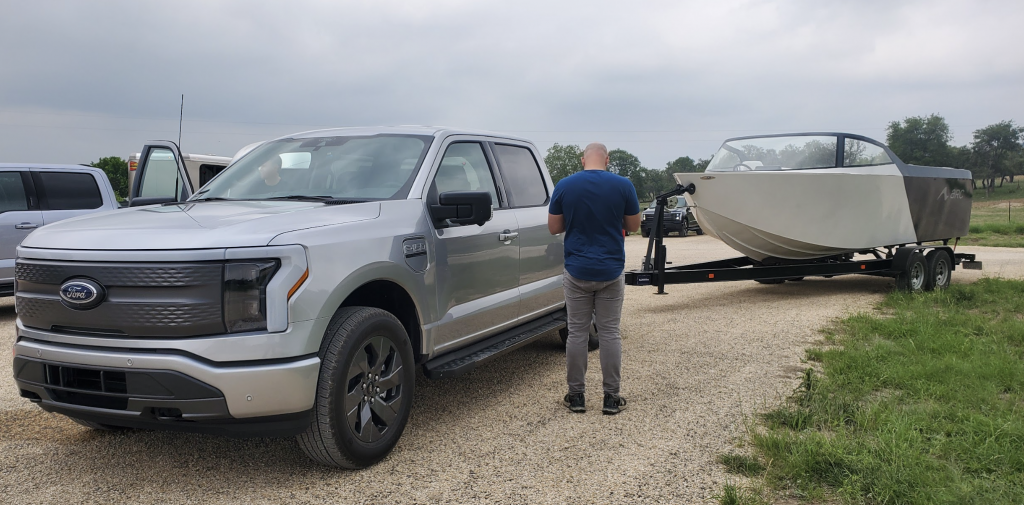
The less-boxy boat above weighs 8,300 pounds, and the truck’s screen said it had 135 miles left based on 88 percent battery state of charge. So at full battery capacity, the truck should go 153 miles.

The truck above towing a 5,000 pound horse trailer said on its screen that at 81 percent, its battery could get the truck 128 miles. That’s about 158 miles if the battery were full.

The truck carrying the heaviest load is this black one. It showed 61 percent battery capacity remaining with an estimated range of 90 miles. Ninety miles divided by 0.61 is about 148 miles. Note that the truck showed an efficiency of 1.1 miles per kWh.

I want to make it clear that these are just estimates, and that none of these trucks were driving at highway speeds, plus I don’t really know how much driving data the trucks had to base these figures off of, but in a world where people seem endlessly curious about how well and how far electric vehicles can tow, I figured this would be better than nothing. I’ve included Ford’s claimed charging times above, so you can get an idea of how long it’d take to get another 150-or-so miles out of your tow rig.
Off-Road
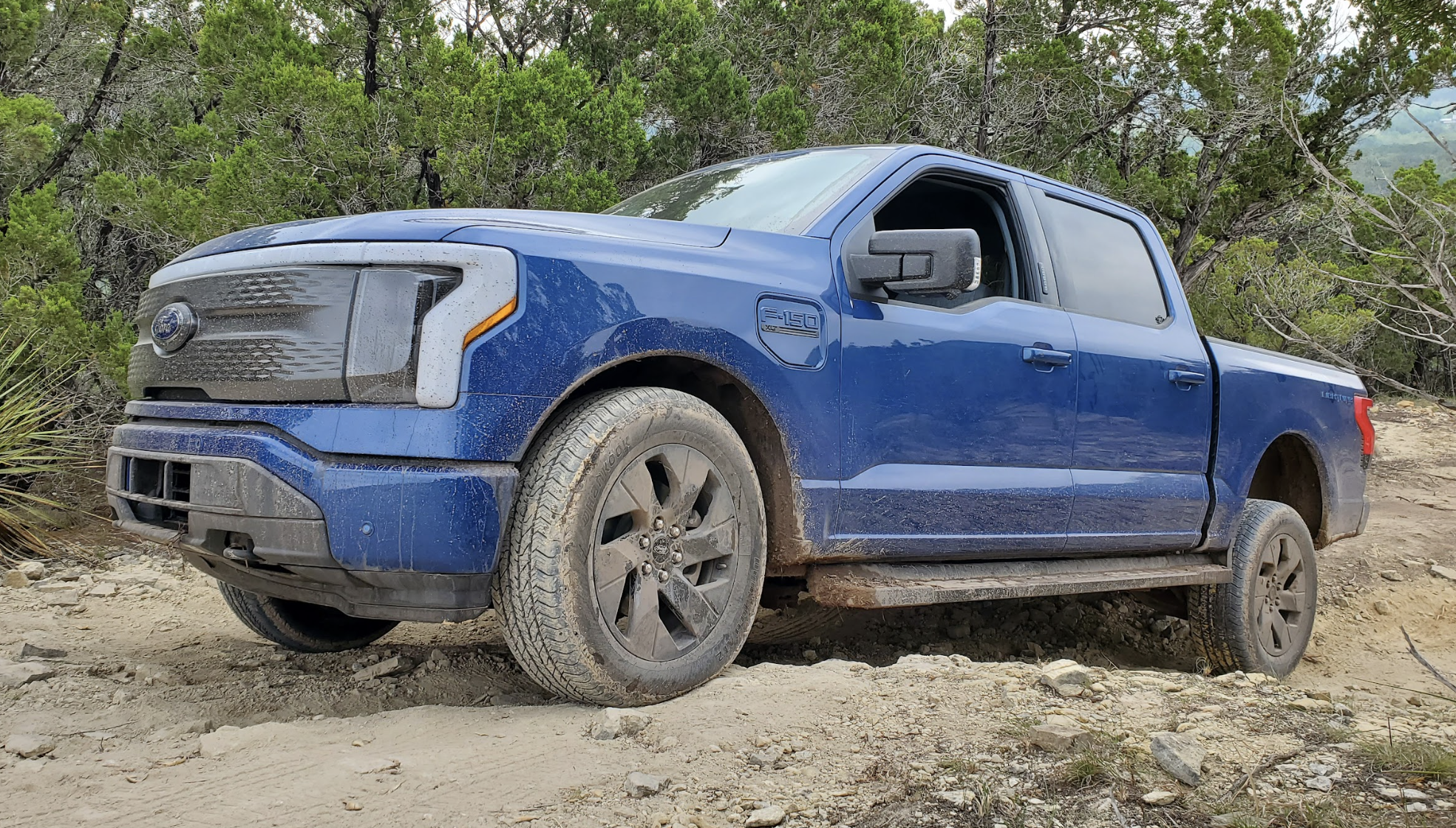
The Ford F-150 Lightning is not an off-road vehicle, but it is a pickup truck, and with that classification come certain expectations.
I took the Lightning off-road on a fairly mild course in San Antonio, and had a chance to climb up some hills and bomb through some mud pits. The truck did very well. The standard locking rear differential — activated with a press of a button on the touchscreen — mechanically connects the two rear tires together, and provides a significant traction advantage. Up front is an open differential, though a brake-based traction control system (often called a Brake Lock Differential) does a decent job apportioning power to the wheel with grip.

Obviously, with the solid rear axle gone, overall suspension flex is down over the gas truck, but honestly, the rear suspension travel is not insignificant:



When one tire does lift off, you’ll be glad you have that rear locker to make sure power gets to the ground. 
I have to give some credit to whoever did the pedal calibration for the truck. When in off-road mode (which you select on the touchscreen), I found it easy to precisely modulate the truck’s speed when climbing steep grades. In many trucks, I tend to surge over the tops of hills, or I have to keep my foot on the brake pedal to keep speeds down, but with the F-150 Lightning, I could climb grades incredibly slowly while having only my right foot on a pedal.
In lower load scenarios (i.e. not climbing steep grades, maybe going over a log), I found that it was a little harder to modulate speed. The truck tended to want to go faster than I wanted, so I did find myself using left-foot braking. This is an instance where I’d have liked at least the option of one-pedal drive mode, which is only available outside of the off-road drive mode. One-pedal drive basically slows the vehicle to a stop unless the driver is on the accelerator pedal, so it’d help in scenarios where one wants to avoid gaining too much speed, such as when traveling downhill.

In fact, there is no hill descent control at all on the Lightning — you just have to ride the brake. This isn’t a huge deal, since the brake pedal “blends” regenerative braking with friction braking, but it’d still be a bit nicer to have the machine keep you under control so that it’s not just your right foot preventing you from careening down a hill at 30 mph. It’s a little unnerving, especially as someone with lots of off-road experience who’s used to using low-range gearing and engine braking to keep speeds under control.
Ford did offer an explanation for the lack of one-pedal driving in off-road mode: Basically, one-pedal driving mode pretty much sacrifices some amount of pedal travel — say, 20 percent. So if you’re not pressing the pedal 20 percent, you’re decelerating. “That means you’ve taken away 20 percent of your pedal travel from your acceleration ranges, so that’s less fidelity that we can give you for power application.”
Hmm.
In either case, on a vehicle like the Lightning, which really isn’t meant for hard-core off-roading, I think Ford made some smart decisions, as the vehicle is capable enough despite its geometry, which is rather limiting.

The ground clearance wasn’t too bad, but that low-slung battery, along with the long wheelbase, meant that battery subframe rubbed while I was off-road. I anticipate breakover angle being the biggest limitations to the truck’s capabilities, which again, are more than adequate.
Update: One thing I forgot to mention was that I heard quite a bit of “clicking” while off-road, especially in low-traction situations like the mud pit. The clicking was unlike anything I’d heard from any conventional ABS pump, so I wasn’t sure what was going on. It sounded like relays. Well, a friend of mine reached out and mentioned the brake parts I showed in my underhood photos, saying he sees a “one box” braking system with combined booster, master cylinder, and ABS controller (this single system decides how to decelerate the truck by choosing how to blend regen and hydraulic braking). “If you’re on ice you’ll be able to hear all the clicks and clacks,” he told me of such a setup. And that reminded me of the clicks and clacks I heard in that mudpit. Anyway, the point is: You hear braking clicks while off-roading the Lightning. It’s no big deal.
Conclusion

I mentioned in my introduction that electric cars built on gasoline platforms tend to be highly compromised machines. Vehicles like the VW e-Golf and the electric Mini come to mind. These cars are built on unibody platforms that, by their very nature, are shaped in a precise way that optimizes packaging efficiency for a gas vehicle. The unibodies not only integrate the vehicle’s structure, but they also envelop major components like the gas tank, exhaust, and driveshafts. The bodies are literally purpose-designed for gasoline powertrains.
Fitting a big flat battery pack under the decidedly-not-flat body of a car specifically built with provisions for ICE components just doesn’t work well.; The vehicles tend to fit too few batteries, or those batteries are in a weird location, and the end product tends to weigh too much (since the battery wasn’t integrated into the body’s structure in the first place).
Things are different with a body-on-frame machine. If you look at how a truck is built at a plant, you’ll see that the frame acts sort of like a Tesla “skateboard” in that it contains the suspension, and the main drivetrain and powertrain components are mounted to it. A body sits on top.

A body-on-frame setup lends itself well to electrification, since there’s so much space between the rails. Unibody proponents have said that this is wasted space, and part of the reason why body-on-frame vehicles tend to have taller floors and less interior volume, but for the purpose of electrification, this “wasted space” is actually quite welcome. Ford was able to clear out enough stuff from between its frame rails to fit a humongous battery, as well as a complete, high-performance electric drivetrain — all with zero compromises to interior volume. In fact, the frunk actually increases overall volume.

Of course, there are compromises associated with going this route. Mounting a 1,600 pound battery on a heavy ladder frame, and not using the battery as part of the vehicle’s structure doesn’t seem like the best way to keep weight down, and if I had to guess, the truck could have been better optimized for aerodynamics had it not used the same cab as the gas truck.
Speaking of integrating the battery, I think a ground-up new platform likely would have tucked that thing up a bit. As it sits, the battery hangs down below the rockers in a way that’s not particularly aesthetically pleasing, adding a bit of bulk to the side profile:

Side steps help with that:

Anyway, I mention all of this because engineering is literally the art of compromising. And when I look at the Ford F-150 Lightning, all I can see is brilliant engineering from a company that can’t seem to miss right now. The few compromises I just mentioned were clearly, without question, the right ones to make in order to share enough components to allow Ford to build the first mainstream full-size electric truck in U.S. history quickly, in a price range that appeals to consumers, and in a way that should maximize quality (since many of the components have already been vetted) — and also to execute it all well. And Ford has. This truck is quick, it rides great, its EPA-rated range is solid, it’s unbelievably quiet, and above all — it’s familiar.
And that last point, as I’ve said before, has the potential to shift America towards electrification like no vehicle ever has.









I’m really curious how closely the Lightning’s IRS is to the Expedition’s. Both are body on frame F-150 derived vehicles with IRS. My dad’s 2004 Expedition has similar ungodly huge cast aluminum rear lower control arms like that Lightning. Although I think the Expedition has double A arm rear over trailing arm.
I don’t drive (or have room to park a pickup truck), but this review made me want to try out this truck. Excellent, in-depth reporting with just the right amount of nerding out–I don’t have *any* of the technical know-how that would make the more technical parts of this article make sense, but DT’s enthusiasm for the novel solutions Ford came up with showed through in those parts.
Question: on the interior photo with the extra big infotainment screen, it looks like the shifter is folded down into the console. Is that an optical illusion? If not, is that a normal feature on a regular F-150?
other F150s have it, I’m not sure if it is standard or an add on though
What’s the purpose of doing that–just to get it out of the way of the screen? Does it let you do that while you’re driving? I’m legit confused!
It allows you to fold the top of the center console forward for a flat work surface.
It’s an add on. My ’21 F150 has it… I don’t use it much, so I wouldn’t have it if I’d ordered the truck. Nice surface to eat off of tho.
I used to occasionally drive a company fleet Focus EV, and it featured that exact same bizarre torque steer that ping ponged left and right. And it wasn’t particularly quick either. Never felt anything like it in any other car.
A rental V8 front drive 2004 or 2005 Chevy Impala SS tried to kill me with a stupid “traction control” system that worked by alternating brake engagement right to left. Maybe it was trying to get drivers that “fish tailing” feel? All I wanted to do was move from a stopped lane waiting for an offramp I didn’t want to a moving lane without getting smashed. I (like David) thought maybe it was me correcting in some sick system harmonic with the automated system. I disabused myself of that misconception by locking my arm to body to wheel in an open space and hammering it. The damn thing threw itself from side to side all by itself.
This. This is why the Lightening and also the Maverick will do well. Just familiar trucks. No edgy styling, no unneeded Autonomous drive trying to kill you. Just a useful truck. Why do all the EVs have to be edgy, futuristic. Just make normal vehicles that happen to have EV drive.
And Yes, I realize the Maverick is not EV, but is hybrid without trying so hard to scream “I’m hybrid, so I must be styled like I’m from year 2075”
It also doesn’t scream “I’m really a unibody car underneath” in any form as loudly as most any other car-based pickup has been (Subaru BRAT and Baja, Dodge Rampage, even the Santa Cruz with its curvy C pillar similar to the others mentioned. The Maverick looks like a shrunken F-150 SuperCrew.
I saw my first Maverick ” In the wild” Over the weekend. They are pretty cool looking, sort of refreshing looking. I had to do a double take. Because I own a 1996 Tacoma- the small one with 2Wd. I have not seen a new truck closer to the size of mine in many years
Curious question: Since I think the was the first official press event for The Autopian, what did the other journalist say to you?
Congrats, mostly. Some offered to help in any way they can. Good folks!
At 5:42 in the Walkaround video, it appears Trent Crimm from The Independent would like to ask a followup question.
https://youtu.be/C64CNLihq-Q?t=342
What was the point/purpose of the shots with the C10?
What kind of question is that?! The thing is beautiful!
all that aluminum means it’ll never have proper patina.
He needed to lick the undercarriage to meet his daily rust intake. David Tracy can’t survive long without iron oxide.
So good to see a deeper dive into the engineering. Most reviews are just features and driving, but it was really nice to see an analysis of construction and such.
Love the deep review.
Not that it is my key factor when looking at a vehicle, but considering the massive differences between this vehicle and the Bronco, and how similar your praise of their offroad capabilities are it sounds like Ford’s offroad team are on the ball.
One question I didn’t see explicitly answered; I’ve noticed with a few of Ford’s newer vehicles that there’s a disconnect in roadfeel, a rental Ranger I drove was the worst of these as it literally felt like I was operating the vehicle from a remote station with inputs transmitted back to me. Steering, acceleration, noise, brakes and all the rest, it felt like I was getting road input half a second delayed, like I was driving encased in wool. Is there any similarity in the Lightning? The lack of engine noise in a vehicle is one thing I just don’t have any concept of, but I can’t imagine that it would aid in feeling connected to the road.
I think, when it comes to feeling connected to the road, in many ways, it’s lag that’s the enemy. When you steer the wheel, you expect the nose to dart that direction. When you accelerate, you expect a downshift. When you press the brake pedal hard, you expect urgency.
The Lightning isn’t going to amaze you with its handling/steering (though I didn’t find the steering any more disconnected than on the F-150; I didn’t mind it), but the response to pedal input goes a long way in helping you feel connected. It’s like an automatic with the fastest downshift ever.
not a truck guy, but would adding 5psi to the fronts get you back some of that immediate steering response?
Man, that frunk is huge. I kinda love it. I really hope that they are in the process of making a Ranger Lightning. That would be pretty sweet. I’d really love something Maverick-sized, but DT makes excellent points about the unibody vs body-on-frame ease of conversion. I’m definitely giving this serious thought for my next DD purchase in a couple of years so I can also use it as a house battery. The massive price jump between the Pro and Lariat trims is a bit of a bummer, though.
Agreed about how great that frunk is. I could definitely make good use of a truck’s open bed, but could never stomach giving up enclosed cargo space. This is the best of both worlds and is the first time I’ve ever seriously been enticed by an electric vehicle or truck. I still want more range than is being offered, but I could definitely see something similar to this in my future.
Most trucks already have ample enclosed cargo space. As soon as I got my truck, I unbolted the idiot seats in the rear, and have never wanted or needed to put them back.
“The first F-150 Lightning I drove was a $56,100 base “Pro” model with the extended range battery that promises 320 miles of range”
Exactly the model I want. They currently lock the extended battery to the XLT, putting the starting price for that range at over $72k (over 74 after destination). I’m hoping that this means they will eventually allow us to order the extended battery pro.
Also, I’m glad you were willing to get in there and drop their clips down the abyss. Because I absolutely would do the same, so it is good to know it happens.
Apparently the Pro/Extended range battery is available to fleet customers, which is probably the spec that David drove it in. TBD if they make that option available non-fleet.
Now I just want to set up an Autopian reader fleet so we can collectively order these. If we order through a Tennessee dealer, it’s also a good chance to visit the excellent museum we keep reading about!
The Pro’s we have in the shop are in fact fleet only right now, so basic work truck with the bigger battery. sticker on them is just under 50K, the comparable gas trucks are around 45K. it certainly would be nice to be able to get a Pro to avoid some range anxiety.
A friend of mine cancelled his Lightning order over the XLT/extended battery situation and ordered a Rivian. How that works out remains to be seen…
So did I. Super excited about the Lightning but just wasn’t going to play those pricing games. If Ford would do just a base level with the extended battery they would sell a gazillion of these things and own the market. A 300+ mile range EV that hauls my shit AND can power my house for $55k? Take my money. But I am not spending an extra $20k for a $10k option. Cancelled my Lighting reservation and signed up for a Silverado. Let’s see how that goes…
Now that’s a review. I now feel that I know what the truck is all about. I don’t want one, but I now know it for sure. Looking forward to reading more “Autopinion” (kinda catchy, eh?) features in the future.
Came to say the same. Saw some comments worried that all new car reviews would turn this site into Car & Driver or a some website that rhymes with Kalopnik but I’ll be damned if I didn’t learn more in this review than most any others I’d ever read. If car reviews are this informative, I’d even read one on a Chevy Equinox given that I’d probably learn something new!
I suspect the throttle is that way to keep it familiar for existing drivers.
I’m excited at how it will hopefully turn the volume way down on the non-vehicle-related virtue signaling that orbits EVs generally.
And I mean on both (all?) ends of the spectrum.
The fact that a large old-school industrial company that’s not headed by a celebrity makes something like this is a pretty big deal on a bunch of fronts.
And I wish all car reviews were like this! Great review David
This is the EV that will show America it is possible. Take a well known item, the F-150, and make an EV that does most of what the average user will do and BOOM sales.
The price is not far off from a ICE F-150 either.
For example, I am the dump runner, pick up bulky items, off road is a dirt roar or the mud pit that is the towns mulch pile. For me this ticks all the marks and in a few years when ready to buy and put in my own charger, this would be high on the list. I would still have an ICE for the long road trips.
If this was GM, they’d make it electrocute the passengers and then we would never ever get electrical vehicles.
As a person who is leasing a 2019 Chevy Silverado and returning it this fall to purchase a Mustang Mach-E.
I agree 100%.
Every other trip (but not the ones to the dealership of course), the infotainment center goes completely dark, turns off all HVAC, shuts down the mini-dash screen, while mid-route. Fortunately it seems it only happens when I need my GPS lol, so that’s cool.
Oh and with 15,000 miles the transmission slips terribly, even though it’s always been babied, never towed anything, and I live on paved roads; it’s basically driven like a commuter car.
Great review David!
Yes I love my 2018 Volt and still do not understand why they gave up on that line.
Since many of the (surprisingly subtle) changes to the bodywork are an improvement over the gas version I wonder just how many of them are going to migrate there next facelift.
And to bust out a wonderful term I learned from one of our dear leaders some time ago, will Ford transition to a non skeuomorphic front end?
As in, it currently looks plenty like an ICE grill designed to let in air.
I was wondering the same thing. Assuming the panels are interchangeable between the ICE and EV versions, it would be cheaper to just use the exact same ones. It makes more sense if this is the look for next year’s ICE model being demoed on the Lightning.
Personally I think they both look like small buildings on wheels, but I’m not target audience.
Awesome review.
Sounds like a great vehicle, but one thing is worrisome, the fire risk.
Last time I checked, Teslas caught fire at about the same rate as Ford Pintos did. An engineer friend told me that electric busses in Europe are bursting into flames at a rate of about one a month.
The problem occurs when there is an electrical short somewhere in the battery cells or packs. The underframe protection, therefore, is really important.
This relates to protection from debris bouncing up; but also what you “ran” into, bottoming out. The breakover point is a really big deal here. You don’t want the battery to break when going over something. The results, as you engineers say, are catastrophic.
It looks like there is a pretty robust plate on the bottom of the battery pack. I’m not sure what metal or gauge it is but it must offer some protection if the maker of the Pinto is willing to sell it.
I hope it is more robust than the Mach-E plate. I know someone whose Mach-E was damaged by a piece of metal in the roadway. There was no room to evade and not enough time to stop. It left a dent that could not have been a 1/2 deep and was a couple of inches long on the battery pack. Unfortunately, the dent was right on one of the cooling channels on the bottom. The entire battery pack had to be swapped because they could not be sure if the coolant would flow properly across the entire pack. The insurance company wanted to scrap an essentially brand new vehicle over that. I get that the F-150 will have greater ground clearance, but it is also expected to drive in more rugged areas.
So have you looked at the data or are you afraid because of perception and news stories?
This is a moving data point but as of January EVs are on par with gas cars for vehicle fires. I’d worry about hybrids https://www.kbb.com/car-news/study-electric-vehicles-involved-in-fewest-car-fires/#:~:text=Hybrid%2Dpowered%20cars%20were%20involved,some%20logic%20to%20the%20results.
@Ilikecarsandbikes I looked at the data, based on fires that I could find on google and vehicles sold; and then compared to the Pinto’s fires and vehicles sold.
I say “last time” I checked, which was in January, 2020. It’s pretty time consuming to assemble the data.
Great review.
As an aside, can anyone who loves to constantly complain about “how massive” modern trucks have become please take a look at that side by side shot with a 50 year old C10 to see how ridiculous that claim is?
2022 Ford F-150 Lightning/Dimensions
232″ L x 80″ W x 77″ H
1972 Chevrolet C10 1/2-Ton Pickup
200.5″ L x 79″ x 47.5″ H
Nope, modern trucks haven’t gotten bigger at all /s
You’re comparing a crew cab to a regular cab for one thing, and I’m deeply skeptical of any source that claims a C10 is 47.5″ high.
The 47.5 is the height to the top of the tailgate, I think. Which makes the heights mismatched. Open gate to ground is 27.25 in the C10 vs 37.2 in the Lightning. 70 VS 77.5 overall height. And the above compared lengths aren’t right, either. 207.75 (long bed) or 188.5 (short bed) vs 232.
To be fair, the move from pickups for pickup things to pickups as people haulers has made the standard shift from regular cab to crew cab as the standard. I do think it is fair to say pickups are longer, largely with shorter boxes, because the typical pickup is a crew cab these days.
The Chevy stepside pictured had a lot less usable bed space for the width, since it was entirely between the wheel wells, which might increase size perceptions.
Taller hood, shorter windshield, and other design features also contribute. Pickups have gotten larger, but not necessarily by as much as people think. And they look even larger than they are.
You are also comparing a regular cab C10 to an extended cab F150 length wise (a RCLB 1995 F150 is 213″ long), but keep going off about how a 3″ difference in height and 1″ difference in width over 27 years makes something a monstrosity.
People are out here in comment sections acting like everyone is driving around in Bigfoot monster trucks, when Honda Civics have grown more than full size trucks over the same period of time.
No one can seriously look at that picture and believe there is any appreciable difference in size, other than length due to cab style.
“No one can seriously look at that picture and believe there is any appreciable difference in size, other than length due to cab style.”
Sure I can, I can also take a picture of my thumb in the sky next to the sun and still understand that even though they occupy a similar amount of pixels, they are in no way similar size objects.
The Ford is farther away than the C10, so its best to use measurements instead of a picture
Just use the wheels as a reference. The Pro trim version that David drove has 18″ rims. The C10 is most likely on 15″ ones.
The apples to apples are 19″ longer, 3″ higher and 1″ wider in 27 years, or 24″ longer, 7″ higher and 1″ wider in 55 years. Regular cab, long bed 4×4 models.
If that’s a big deal to you, I guess I won’t be able to change your mind. I’m tired of people complaining that modern trucks are some kind of uniquely large, when in the dimensions that matter the most on the road, they have changed less than other classes of vehicles over the same period of time.
Replying to myself to correct a stat, I had the 2wd height for the C10 at 70″, the more comparable 4×4 K10 was 73″ high, so a 4″ height difference in 55 years.
Great pick with the 04′ Buick Regal which is widely considered the last of the land yaughts. And that unkillable 3800.
When the model was revived it was an Opel rebadge, not exactly a fair comparison.
and you’re always ignoring the change in tailgate/bed height which is something people who actually use trucks to haul things are going to notice rather quickly. My dad had a 2nd gen C-10 and one could reach everything inside the engine bay pretty easily and didn’t need a step stool like I’ve seen many techs need for working on the equivalent current model Silverado. The top of the hood wasn’t at my shoulder height either. Those are the types of things that people complain about.
So you’re not gonna touch the Civic growth spurt? Why, because it doesn’t support your case? lol
I parked my 32 year old F350 next to my buddy’s 1 year old F350 the other day and it was pretty hilarious. Both are identical configurations, long bed crew cab 4×4. Visually his looked like the Hindenburg had arrived and mine like a brick apartment complex but the only real size differences were the height at the top of the hood, the size of the mirrors, and how much nose he had in front of his wheels(mine has no crumple zones).
I’m guessing modern designers have just taken it as a challenge to make trucks look more bloated and gargantuan than when they took out a ruler and designed my brick nose OBS with just enough space to cover most of the mechanical bits.
Don’t forget about aerodynamics, too. Flat fronts with square corners transitioning to flat sides cause flow detachment and drag. It’s not some modern design aesthetic trend, it’s driven by very real flow sim numbers that simply couldn’t even be calculated to remotely the same level of granularity back when the OBS were penned.
And like you noted, extreme leaps in crash safety has driven a lot of underlying size changes. There’s a few ways to achieve good crash test results. Crazy expensive materials and manufacturing processes to reduce bulk, but meet reqs., or just more of the same cheap, conventional materials and means of production. One of these adds bulk, the other adds cost. And at the end of the day, what do most car shoppers look at… Cost. So they accept some bulk to save buck.
In the UK, that C10 would be considered big. A ‘normal’ sized pickup for us is what Americans call a mini-truck.
That said in the last ten years, more and more F150-sized pickups are hitting our roads along with ever bigger SUV’s, so in the UK at least, it’s fair to say that “cars are getting bigger”.
…but did David learn anything from the song???
Can the frunk charge power tool batteries while driving?
Great review, how was the quality of the nap?
Thanks for the review David! I think the torque steer problem is something that could be fixed with a software update once Ford gets more data from real world driving. Though I don’t have a need for an F-150 sized EV truck, I would be interested in a smaller one. I don’t think they’ll use the Maverick as a base since that’s unibody construction so probably the Ranger.
Agreed. I’m not a truck guy, but an electric Maverick is very enticing.
Excellent review, I appreciate your engineering focus. I’m very curious to start hearing more people weigh in on what these are like to own and use on a daily basis, and this piece begins to give a clue to that. Thanks!
Any word from Ford if they are going to use that rear suspension going forward with their ICE trucks?
(I’m usually not a fan of step side trucks, but I’d love to have that Chevrolet)
I highly doubt it since the ICE’s still use a solid axle. If anything, they might switch to the F150 Raptor 5 link, but I would think that might eat into Raptor sales a little.
I’m betting not. IRS tends to have issues when used a lot for towing because the suspension squat makes the rear tires wear unevenly. With only 150 miles of range that won’t be much of an issue for the Lightning, but in the gas trucks that are going to continue to be the mainstay for towing until there is electric infrastructure to support charging with a trailer attached, it’s likely to be a problem.
My company announced yesterday that they’re going to be piloting the F-150 Lightning to see where it might fit in our vehicle fleet. A lot of this makes a lot of sense, given that most of our fleet is currently mostly F-series trucks.
This is the review I’ve been waiting for, thanks for all the work putting this together David!
This review is phenomenal. For how in-depth and lengthy it is, it is way more interesting than it has any right to be. DT has a real gift to make all this technical stuff fun to read even if half of it goes over my head.
Right? No regurgitated press release, but not being ignorantly critical, either. This is why I come here.
Me too. DT does it right on these reviews. Combine that with Torch’s specific brand of crazy, and it’s utopia. Or maybe, Autopia?
I am here because the writing is great, not because I am a car nut.
If it’s about tail lights, hey let’s enjoy it while we have a free country!
Tight. They’re gonna sell boat loads of these things. Making them extremely similar to the gas version makes so much sense, it’s amazing they actually did it. Once the traditional truck for no reason other than it’s a truck contingent realizes how much more these make sense, EV trucks will be commonplace.
This can’t replace all trucks in all situations, not by a long shot. Baby steps.
No one made that claim. For the 95% of people that don’t have a 100 mile commute everyday, this could serve them very well.